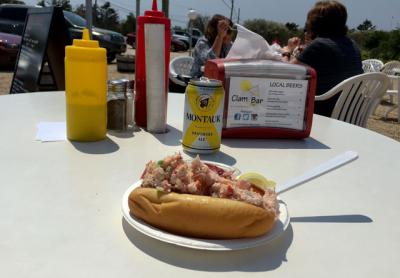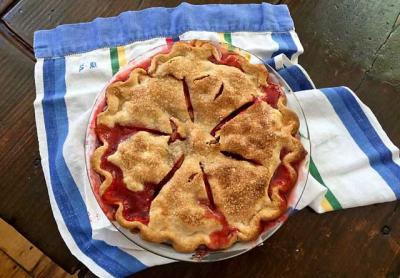Seasons by the Sea: Rest in Peace, Anthony Bourdain
Seasons by the Sea: Rest in Peace, Anthony Bourdain

He was a punk, a hoodlum, a bard. He survived years of addiction to heroin and cocaine. He was occasionally snarky and cynical, but never unkind or disrespectful.
Anthony Bourdain was a chef, traveler, writer, father. His departure from our planet is a crushing blow not just to those in the food world, but to anyone and everyone who enjoyed his books and programs.
Did you know he had a blue belt in Brazilian jujitsu? Did you know he had his own publishing imprint (Anthony Bourdain Books, Ecco Press) under HarperCollins? That he wrote and illustrated a series of graphic novels and a crime series in addition to his restaurant exposés and cookbooks from 1995 to 2016?
Anthony Bourdain was born in New York City and grew up in Leonia, N.J. His father was a record company executive, his mother an editor at The New York Times. He spent time in Montauk in his youth and in later years rented a house somewhere on the East End. He would hang out with his good buddy Eric Ripert, the executive chef and co-owner of Le Bernardin. They even modeled together for Hamptons magazine in 2012. In the pictures they are lounging around outside Sunset Beach on Shelter Island, both lean and lanky, handsome and relaxed. Their witty repartee goes back and forth: Mr. Ripert mentions Hayground School and his favorite charity events; Mr. Bourdain says he intends to putter all summer and wants to be like Ina Garten.
Mr. Bourdain’s book “Kitchen Confidential: Adventures in the Culinary Underbelly” came out of his 1999 New Yorker essay “Don’t Eat Before Reading This.” Everyone in the food world read it. A lot of chefs didn’t like how restaurant kitchens were portrayed — full of cursing, thieving, addiction, and other forms of debauchery. The restaurant where he worked wasn’t fancy. Les Halles was a big brasserie. He once said that if you can survive brunch service (“Three hundred eggs Benedict, not one of them returned!”), you can survive anything. He was prompt for meetings, in fact, always 15 minutes early. “It shows respect,” he pointed out.
His television career began with “A Cook’s Tour” on the Food Network in 2002. From 2005 to 2015 he was the host/writer for “No Reservations” on the Travel Channel, along with the shorter-lived “The Layover.” In 2013 his “Parts Unknown” debuted on CNN.
“I have the best job in the world. I decide where we go. If I’m not having a good time it’s nobody’s fault. It’s a fault of the imagination.”
He traveled for work more than 200 days of the year, with a skeleton production crew. They would pick up extra help at their various shooting locations around the world.
A month ago, my son started working at CNN. The first office picture he sent me was a black-and-white portrait of Anthony Bourdain in the hallways of the Time Warner Center. It got me to thinking how interesting it was that a mother and son, two different generations, would equally admire this man.
Mr. Bourdain, Tony to his friends, was found by his friend Mr. Ripert in his hotel room in Kaysersberg, Alsace, in France. He had missed dinner the night before, then breakfast. He had hung himself. According to the Centers for Disease Control, more than half of all suicides are not related to depression or mental illness. They are related to stress, loss, substance abuse, and relationship problems. Will we ever know why this peripatetic talented man chose to die? Would it really help if we did?
People often hate journalists after a tragic event because they stick a microphone in your face and ask how you feel. But I wanted to get words and thoughts and reflections from people who knew Tony Bourdain. From his friend Geoffrey Drummond (Eric Ripert’s producer for “Avec Eric” on PBS) I received the following:
“It’s so shocking, sad, and certainly a huge loss of someone with immense talent as a writer, charisma as a performer, and insightful wisdom as a commentator. Tony saw food and cooking not so much as an end product but a medium to explore and present people, places, culture and politics through the plates of food they shared with him, and his audience. Having worked with Julia Child, who was a great cook, writer, beloved and iconic TV personality, I see Anthony Bourdain as our contemporary — iconic and iconoclastic. A true and deep loss not just for fans of food, but the world.”
From Chris Cuomo, a colleague of Mr. Bourdain’s at CNN:
“I am not a foodie per se, and so when Bourdain asked me about personal passions, I said ‘my family.’ He was like, ‘no kidding.’ I said ‘fishing.’ He rolled his eyes. Then I said ‘fighting’ and his eyes went wide. He had just fallen in love with BJJ [Brazilian jujitsu] and whenever I would see him thereafter, we would talk fight training and the love of the grind. That’s the weird thing for me — just weeks before his suicide, he told me how into struggling he was; how he loved fighting through challenges. It’s very sad.”
Mr. Bourdain’s programs won numerous Emmys and a Peabody Award. He enjoyed the road less traveled. He touched on politics in his shows but didn’t judge. He ate fermented shark and warthog anus. He said “your body is not a temple, it’s an amusement park. Enjoy the ride.” He had guests ranging from Iggy Pop to President Barack Obama.
He loved the “struggle.” Until he didn’t. Rest in peace, dear man, you can never, will never, be replaced.
Click for recipes





